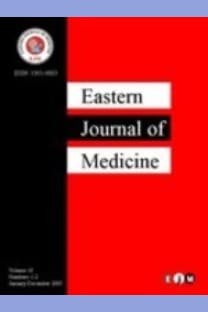Iodine status in vulnerable groups of Linxia Hui Autonomous Prefecture, China
Iodine status in vulnerable groups of Linxia Hui Autonomous Prefecture, China
Iodine deficiency, iodized salt, goiter, urine iodine concentration,
___
- WHO/ICCIDD/UNICEF. Assessment of the iodine deficiency disorders and monitoring their elimination. 3rd edition. Geneva: WHO; 2007.
- WHO/UNICEF/ICCIDD (1999). Progress towards the elimination of iodine deficiency disorders Geneva: WHO document WHO/NHD/99.4
- WHO/UNICEF/ICCIDD. Global prevalence of iodine deficiency disorders. Micronutrient deficiency information system working paper No.1. Geneva: WHO, 1991.
- Chen ZP. IDD hazard control progress and challenge. Geriatr Health Care 2010; 16: 6-11.
- Chen ZP. Progress of IDD elimination in China. J Prev Med Inf 2000; 16: 93-94.
- Pino S, Fang SL, Braverman LE. Ammonium persulfate: a new and safe method for measuring urinary iodine by ammonium persulfate oxidation. Exp Clin Endocrinol Diabetes 1998; 106: 22-27.
- China’s Ministry of Health. The recommended method for measuring iodine in drinking water. Ministry of Health, Beijing. 2001, Document No. 161 (in Chinese).
- Liu LJ, Yin J, Zheng ZH. Determination of iodine in urine mild and vigorous digestion methods followed by ceric arsenite reaction. Chinese J Endemiology 1995; 14: 37-39.
- WHO/UNICEF/ICCIDD (1996). Recommended iodine levels in salt and guidelines for monitoring their adequacy and effectiveness. Geneva: WHO.
- WHO/UNICEF/ICCIDD. Reaching optimal iodine nutrition in pregnant and lactating women and young children. IDD NEWSLETTER 2008; 27: 1-3.
- State Bureau of Quality Technical Supervision. The normal value of thyroid volume in children and adolescents. Chinese Criteria Publishing House, Beijing. 1996, GB16398-1996 (in Chinese).
- China’s Ministry of Health and State Bureau of Quality Technical Supervision. The Criteria of Elimination of IDD. Chinese Criteria Publishing House Beijing: 1995, GB16006-1995(in Chinese). Wang Y, Zhang Z, Ge P, Wang Y, Wang S. Iodine deficiency disorders after a decade of universal salt iodization in a severe iodine deficiency region in China. Indian J Med Res 2009; 130: 413-417.
- Gordon RC, Rose MC, Skeaff SA, et al. Iodine supplementation improves cognition in mildly iodinedeficient children. Am J Clin Nutr 2009; 90: 1264 12
- Wang Y, Zhang Z, Ge P, Wang Y, Wang S. Iodine status and thyroid function of pregnant, lactating women and infants (0-1 yr) residing in areas with an effective Universal Salt Iodization program. Asia Pac J Clin Nutr 2009; 18: 34-40.
- ISSN: 1301-0883
- Yayın Aralığı: 4
- Başlangıç: 1996
- Yayıncı: ERBİL KARAMAN
Servet HACİVELİOGLU, Huseyin OGUZALP, Asli MURATLİ, Fatih ASGUN, Bahadir KİRİLMAZ, Dilek OMUR
Factors affecting mortality in burn patients admitted to intensive care unit
Iodine status in vulnerable groups of Linxia Hui Autonomous Prefecture, China
Pengfei GE, Zhongliang ZHANG, Yanling WANG, Yongqin CAO, Jinxiao Xİ
Knowns and unknowns about regional anesthesia techniques and local anesthetics
Yasemin ISİK, Ugur GOKTAS, Muhammed Bilal CEGİN, Nureddin YUZKAT, İsmail KATİ
Epidemiological features of the lip cancers and it’s relation with smoking
Hakan ÇANKAYA, Mehmet Fatih GARÇA, Nazım BOZAN, Dağhan IŞIK, Ahmet Faruk KIROĞLU
Carbapenem associated seizure in a severe melioidosis patient: A case report
Josephine Henry BASİL, Chee Ping CHONG
Chandan Kumar SHAW, Prachi SHAW, Tejesh MALLA, Kalpana K MALLA, Jalaj BAXİ
Deepak MİSHRA, Prashant BHUSHAN, Mahendra K SİNGH, Om P MİSHRA
Clinical manifestations of tuberous sclerosis complex
Ahmet ENGİN ATAY, Halit AKBAS, Nafi SAKAR, Semir PASA, Seyhmus ARİ, Nazim EKİN
Two patients with subarachnoid hemorrhage in pregnancy
Hayriye GONULLU, Sevdegul KARADAS, Mehmet Resit ONCU, Mehmet TASDEMİR
